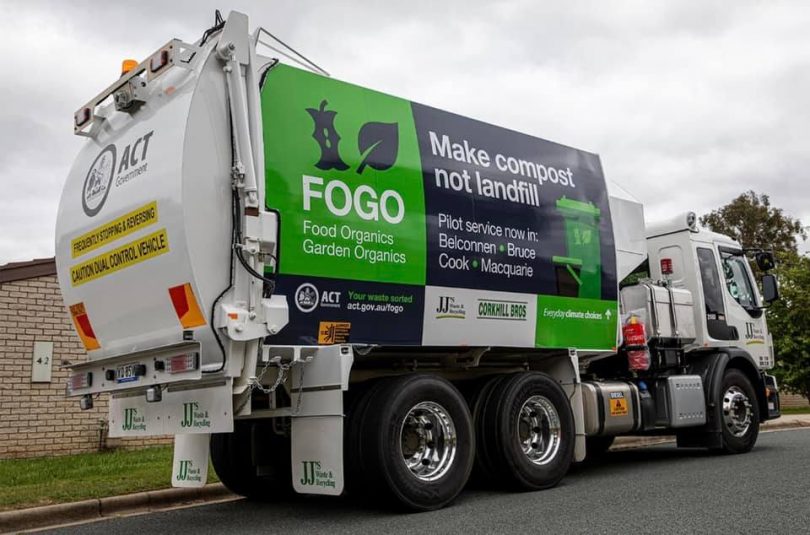
Rubbish collection will become fortnightly under the trial. Photo: ACT Government.
The long-awaited food organics and garden organics (FOGO) bin collection pilot has begun, with Belconnen, Bruce, Cook and Macquarie the first four suburbs to receive the service.
As part of the pilot, participating households are asked to put food scraps in their kitchen caddy which is then emptied into the FOGO bin along with the garden waste.
The pilot will determine contamination levels and get a better gauge on what percentage of Canberrans’ rubbish is made up of compostable items. Multiple apartment complexes will also be a part of the pilot.
Having the use of the new green bin does, however, mean that the rubbish service in the four suburbs will move from weekly to fortnightly collection. The FOGO bin will be collected weekly as part of the pilot.
Projects and Partnerships Coordinator at Canberra Environment Centre Zoe Anderson welcomed the FOGO service.
“Our stance at the environment centre is that we want sustainability to be easy for everyone and that separating organic waste out of our waste stream preventing it from going to landfill is a really effective way of assisting everybody in being sustainable,” said Ms Anderson.

FOGO kitchen caddies will be provided as part of the pilot. Photo: ACT Government.
She added that it provided a “great opportunity” for people living in apartments who otherwise would be unable to compost.
She wanted to stress the urgency of avoiding contamination of your organics, particularly from toxic chemicals.
“It is really important not to contaminate the FOGO bins and that’s because the products that we’re making from the food and garden waste is going to be a landscaping product. It’s going to be compost and we will hopefully be able to use it on landscapes around Canberra,” said Ms Anderson.
The items that should go in the FOGO bin are:
- Leftovers and cooked food
- Yogurt, cheese and eggs
- Fruit and vegetable scraps
- Meat/fish scraps and bones
- Bread, grains and cereals
- Certified compostable liners
- Grass clippings
- Pruning, cuttings, trimmings
- Twigs and sticks
- Palm fronds
- Weeds.
Items that shouldn’t go in the FOGO bin are:
- Plastic bags
- Teabags
- Animal droppings
- Cat litter
- Hair
- Paper
- Tissues and paper towel
- Oyster shells
- Plastic products
- Sanitary products
- Treated timber
- Metals
- Glass
- Textiles and old clothes.
Minister for Transport and City Services Chris Steel said that with 93 per cent of surveyed Canberrans indicating support for the FOGO collection, the pilot will help determine how to roll out the service to all of Canberra.
“FOGO will help Canberrans to take everyday action on climate change by turning food and garden waste into nutrient-rich compost, thereby reducing methane gas being generated from our landfill. Once implemented city-wide, this has the potential to reduce waste emissions by up to 30 per cent,” Mr Steel said.
All households in the pilot should have received educational material, an updated collection calendar, a kitchen caddy, compostable bin liners and a FOGO bin.
For further information, visit City Services.


















